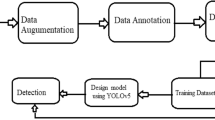Abstract
Deaf and dumb people use sign language as a tool for communication. As per the 2011 census in India, hearing impaired and speech disabled population is 1,998,692 and 5,072,914 respectively (Disabled persons in India, https://www.mospi.gov.in). Normal hearing people do not learn sign language and thus there is a big communication gap between them and deaf and dumb people. Sign language interpreters can fill this gap but it is a very costly affair to hire them. Indian Sign Language (ISL) consists of signs which are made with two hands while other sign languages like American Sign Language consists of signs made with single hand. This work proposes an automatic and efficient computer vision based system to recognize ISL alphabet which can assist this communication. It can further be used as a module of complete ISL recognition system. Phases in ISL alphabet recognition are image acquisition, preprocessing, segmentation, feature extraction and classification. All 26 ISL alphabet have been considered for testing with average accuracy of 80.76%. Results show that the accuracy of 100% is achieved when similar alphabet {C, L, M, N, R, U,Y} are excluded from testing dataset.







Similar content being viewed by others
References
Hore S, Chatterjee S, Santhi V, Dey N, Ashour AS, Balas VE, Shi F (2015) Indian sign language recognition using optimized Neural Networks. In: Proceedings of the 2015 International Conference on Information Technology and Intelligent Transportation Systems ITITS 2015, held December 12–13, 2015, Xi’an China, pp 563–573
Dour S, Sharma MM (2016) Recognition of alphabets of Indian sign language by Sugeno type Neural Network. Int J Sci Res Public 6(3):442–453
Kumar DA, Kishore PVV, Sastry ASCS, Swamy PRG (2016) Selfie continuous sign language recognition using neural network. In: IEEE annual India conference (INDICON), pp 1–6
Uddin MA, Chowdhury SA (2016) Hand sign language recognition for Bangla alphabet using support vector machine. In: IEEE international conference on innovations in science, engineering and technology (ICISET), pp 1–4
Hosoe H, Sako S, Kwolek B (2017) Recognition of JSL finger spelling using convolutional neural networks. In: IEEE fifteenth IAPR international conference on machine vision applications (MVA), pp 85–88
Mukai N, Harada N, Chang Y (2017) Japanese fingerspelling recognition based on classification tree and machine learning. In: Nicograph international (NicoInt), pp 19–24
Pariwat T, Seresangtakul P (2017) Thai finger-spelling sign language recognition using global and local features with SVM. In: 9th IEEE international conference on knowledge and smart technology (KST), pp 116–120
Rokade YI, Jadav PM (2017) Indian sign language recognition system. Int J Eng Technol 9:189–196
Kiran Kumar E et al (2018) Early estimation model for 3D-discrete indian sign language recognition using graph matching. J King Saud Univ. https://doi.org/10.1016/j.jksuci.2018.06.008
Kaur J, Rama Krishna C (2019) An efficient Indian sign language recognition system using sift descriptor. Int J Eng Adv Technol (IJEAT) 8(6):1456–1461
Hamed A, Belal NA, Mahar KM (2016) Arabic Sign Language alphabet recognition based on HOG-PCA using microsoft Kinect in complex backgrounds. In: IEEE 6th international conference on advanced computing (IACC), pp 451–458
Parcheta Z, Martínez-Hinarejos CD (2017) Sign language gesture recognition using HMM. In: Iberian conference on pattern recognition and image analysis. Springer, Cham, pp 419–426
Kim SY, Han HG, Kim JW, Lee S, Kim TW (2017) A hand gesture recognition sensor using reflected impulses. IEEE Sens J 17(10):2975–2976
Kumar P, Saini R, Roy PP, Dogra DP (2017) A position and rotation invariant framework for sign language recognition (SLR) using Kinect. Multimed Tools Appl 77(7):8823–8846. https://doi.org/10.1007/s11042-017-4776-9
Abraham A, Rohini V (2018) Real time conversion of sign language to speech and prediction of gestures using Artificial Neural Network. 8th International Conference on Advances in Computing and Communication (ICACC-2018). Procedia Comput Sci 143:587–594
Islam MM, Siddiqua S, Afnan J (2017) Real time hand gesture recognition using different algorithms based on American Sign Language. In: 2017 IEEE International Conference on Imaging, Vision & Pattern Recognition (icIVPR)
Kang B, Tripathi S, Nguyen TQ (2015) Real-time Sign Language fingerspelling recognition using convolutional Neural Networks from Depth map. In: 2015 3rd IAPR Asian Conference on Pattern Recognition, pp 136–140
Kumar R (2017) Fingerprint matching using rotational invariant orientation local binary pattern descriptor and machine learning techniques. Int J Comput Vis Image Process (IJCVIP) 7(4):51–67
Kumar R, Chandra P, Hanmandlu M (2013) Fingerprint matching using rotational invariant image based descriptor and machine learning techniques. In: 2013 6th International Conference on Emerging Trends in Engineering and Technology (pp. 13–18). IEEE.
Author information
Authors and Affiliations
Corresponding author
Rights and permissions
About this article
Cite this article
Kumar, A., Kumar, R. A novel approach for ISL alphabet recognition using Extreme Learning Machine. Int. j. inf. tecnol. 13, 349–357 (2021). https://doi.org/10.1007/s41870-020-00525-6
Received:
Accepted:
Published:
Issue Date:
DOI: https://doi.org/10.1007/s41870-020-00525-6




